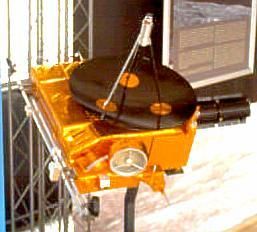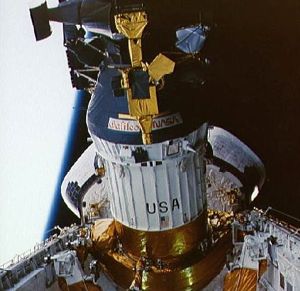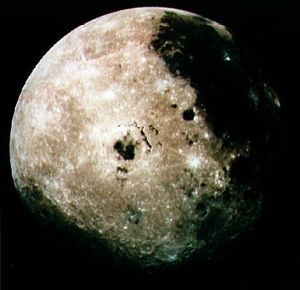
Home - Search - Browse - Alphabetic Index: 0- 1- 2- 3- 4- 5- 6- 7- 8- 9
A- B- C- D- E- F- G- H- I- J- K- L- M- N- O- P- Q- R- S- T- U- V- W- X- Y- Z
Galileo
 Galileo Credit: NASA |
Status: Operational 1989. First Launch: 1989-10-18. Last Launch: 1989-10-18. Number: 1 . Gross mass: 3,881 kg (8,556 lb). Height: 6.15 m (20.17 ft).
The spacecraft's primary mission was the deployment of an atmospheric probe into Jupiter's atmosphere. During interplanetary cruise, deployment of Galileo's high gain antenna failed, forcing use of the its low gain antennas at much lower than planned data rates. Despite the failure, a series of mission extensions and software improvisations resulted in the original science objectives being vastly exceeded. Galileo also performed two asteroid flybys and obtained images of the far side of Jupiter when Comet Shoemaker-Levy impacted in July 1994.
Galileo was designed to perform in-depth studies of Jupiter's atmosphere, satellites, and surrounding magnetosphere. The mission was named in honor of Galileo Galilei, the Italian Renaissance scientist who discovered Jupiter's major moons in 1610. The spacecraft's primary mission was the deployment of an atmospheric probe into Jupiter's atmosphere. Following deployment of the probe, the spacecraft went into orbit around Jupiter to continue its investigations.
At the beginning of Galileo's interplanetary cruise, the planned deployment of the high gain antenna failed on 11 April 1991. Subsequent attempts to release it also failed. This forced use of the low gain antennas at an order-of-magnitude lower than planned data rate. Heroic efforts by JPL staff to develop workarounds resulted in virtually no loss of science data. During its flight to Jupiter, Galileo also performed the first and second asteroid flybys - Gaspra (October 1991) and Ida (August 1993). Galileo was also the only vehicle in a position to obtain images of the far side of Jupiter when more than 20 fragments of Comet Shoemaker-Levy plunged into Jupiter's atmosphere in July 1994. The Galileo probe was released on 12 July 1995 and entered Jupiter's atmosphere on 7 December 1995. Problems with the tape recorder on 11 October 1995 also forced workarounds, but Galileo provided years of service in Jupiter orbit.
The orbiter was dual-spin stabilized. The spinning section (3 rpm) housed fields and particles instruments, antennas, propulsion system, computers, and most other support systems. The despun section provided fixed orientation for remote sensing instruments, star scanner, and gyros. The bipropellant propulsion system (HHM, NTO) from the Federal Republic of Germany used 12 x 10 N thrusters, 1 x 400 N main engine. S-band communications were through two omni low gain antennas (40 bps typical). The deployable 4.8 meter wire mesh high gain antenna failed to unfold and could not be used (planned downlink rate >100 kbps). Redundant flight computers with high level of fault protection kept Galileo operating throughout its extended mission.
The orbiter was powered by two radioisotope thermal generators (570 W BOL, 485 W EOL). An 11 meter deployable boom provided mounting for some science instruments. Orbiter Payload:
- Near-Infrared Mapping Spectrometer (NIMS) - made multispectral images for atmosphere and surface chemical analysis
- Ultraviolet Spectrometer (UVS) - studied gases
- Solid-State Imager (SSI) - visible imaging with 800 x 800 array CCD
- Photopolarimeter (PPR) - measured radiant and reflected energy
- Magnetometers (MAG)
- Dust Detection Experiment (DDE)
- Plasma Investigation (PLS)
- Energetic Particle Detector (EPD)
- Plasma Wave Investigation (PWS)
- Radio Science Probe
The probe consisted of a deceleration module, comprising an aeroshell and aft cover, for reentry and thermal control. A 2.5 m parachute controlled descent following deceleration module release. The descent module contained redundant L-band transmitters, an instrument package, and batteries. Downlink to the Orbiter was at 128 bps. Primary lithium-sulfur batteries (18 Ahr total) provided power during descent.
Probe Payload:
- Atmosphere Structure Experiment - measured temperature, pressure and deceleration
- Probe Mass Spectrometer - atmospheric composition studies
- Helium Abundance Detector - atmospheric composition studies
- Probe Nephelometer - cloud location and cloud-particle observations
- Net Flux Radiometer - measured the difference, upward versus downward, in radiant energy flux at each altitude
- Lightning and Energetic Particles - measured light and radio emissions associated with lightning and energetic particles in Jupiter's radiation belts
Financial/Operational:
NASA NSSDC Master Catalog Description
The Galileo mission consists of two spacecraft: an orbiter and an atmospheric probe. The orbiter will be the sixth spacecraft to explore the Jovian magnetosphere, but the first to be placed into orbit around the giant planet. Scientific objectives addressed by the orbiter are to: (1) investigate the circulation and dynamics of the Jovian atmosphere; (2) investigate the upper Jovian atmosphere and ionosphere; (3) characterize the morphology, geology, and physical state of the Galilean satellites; (4) investigate the composition and distribution of surface minerals on the Galilean satellites; (5) determine the gravitational and magnetic fields and dynamic properties of the Galilean satellites; (6) study the atmospheres, ionospheres, and extended gas clouds of the Galilean satellites; (7) study the interaction of the Jovian magnetosphere with the Galilean satellites; and, (8) characterize the vector magnetic field and the energy spectra, composition, and angular distribution of energetic particles and plasma to a distance of 150 Rj.
The structure of the orbiter is divided into two sections. The main body of the spacecraft, comprised of the electronics bays, propellant system, RTG and science booms, and high-gain antenna, rotates at rates of 3.25 or 10.5 rpm. The despun section, aft of the main body, uses an electric motor to drive it counter to the rotation of the main section. This dual spin attitude control system accommodates instruments which require stable, accurate pointing (the imaging instruments) and those which benefit from repetitive, broad-angular coverage (the various particles and fields instruments). The length of the spacecraft is 9 m and, with the high-gain antenna (HGA) deployed, is 4.6 m in diameter.
Power is provided to the spacecraft through the use of two radioisotope thermal generators (RTGs), each of which is located at the end of a short boom. The magnetometer sensors and plasma wave antenna are located on yet another boom, 10.9 m in length.
Although it was intended that communications with the Deep Space Network (DSN) would be primarily through the HGA (which would remain pointing toward the Earth at all times), thermal constraints forced the use of the two low-gain antennas prior to the first Earth flyby. HGA deployment was planned thereafter, but at least three of the HGA "ribs" were unable to be moved much beyond their launch configurations, thereby jeopardizing the total science return of the mission. Several attempts have been made to deploy the antenna through a variety of techniques.
More at: Galileo.
| Galileo probe American Jupiter atmospheric probe. Launched 1989.10.18 aboard the Galileo orbiter. Deployed from Galileo 13 July 1995; entered Jupiter atmosphere 7 December 1995. |
| Galileo-IOV PFM, FM2, FM3, FM4 Navigation satellite built by EADS Astrium for ESA, Europe. Launched 2011 - 2012. |
Family: Outer planets. Country: USA. Engines: S400. Launch Vehicles: Space Shuttle. Launch Sites: Cape Canaveral, Cape Canaveral LC39B. Agency: JPL, NASA. Bibliography: 2, 279, 3738, 3739, 3740, 3741, 3742, 3743, 3744, 6.
 | Galileo |
 | Galileo Credit: Manufacturer Image |
 | STS-34 STS-34 Galileo spacecraft / IUS deployment sequence in OV-104's payload bay Credit: NASA |
 | STS-34 STS-34 Galileo spacecraft / inertial upper stage (IUS) deployment Credit: NASA |
 | STS-34 Moon taken by Galileo after completing its first Earth Gravity Assist Credit: NASA |
1989 October 18 - . Launch Site: Cape Canaveral. Launch Complex: Cape Canaveral LC39B. Launch Platform: MLP1. LV Family: Shuttle. Launch Vehicle: Space Shuttle.
- Galileo Probe - . Mass: 339 kg (747 lb). Nation: USA. Agency: NASA. Class: Outer planets. Type: Outer planets probe. Spacecraft Bus: Galileo. Spacecraft: Galileo Probe. COSPAR: 1989-084E. Atmospheric probe; deployed from Galileo 7/13/95; entered Jupiter atmosphere 12/7/95. Entry into Jupiter Dec 7.
- Galileo Probe - . Nation: USA. Agency: NASA. Program: STS. Spacecraft Bus: Galileo. Spacecraft: Galileo Probe. Decay Date: 1989-10-23 . USAF Sat Cat: 20297 . COSPAR: 1989-084xx. Apogee: 333 km (206 mi). Perigee: 297 km (184 mi). Inclination: 34.30 deg. Period: 90.80 min.
- Galileo - .
Payload: Atlantis F5 / Galileo [IUS]. Mass: 3,881 kg (8,556 lb). Nation: USA.
Agency: JPL,
NASA.
Class: Outer planets.
Type: Outer planets probe. Spacecraft Bus: Galileo.
Spacecraft: Galileo probe.
Decay Date: 2003-09-21 . USAF Sat Cat: 20298 . COSPAR: 1989-084B.
Deployed from STS-34 18 October 1989; entered Jupiter orbit 7 December 1995 and conducted investigations of Jupiter's moons, atmosphere, and magnetosphere. Although the antenna failed to deploy, NASA developed workarounds and the spacecraft cruised the Jovian system for eight years. Its propellant then depleted, it was maneuvered to enter the Jovian atmosphere on September 21, 2003, at 18:57 GMT. Entry was at 48.2 km/s from an orbit with a periapsis 9700 km below the 1-bar atmospheric layer. The spacecraft continued transmitting at least until it passed behind the limb of Jupiter at 1850:54 GMT, at which point it was 9283 km above the 1-bar level, surprising Galileo veterans who feared it might enter safemode due to the high radiation environment. On its farewell dive, it had crossed the orbit of Callisto at around 1100 on September 20, the orbit of Ganymede at around 0500 on September 21, Europa's orbit at about 1145, Io's orbit at about 1500, Amalthea's orbit at 1756, and the orbits of Adrastea and Metis at 1825. Galileo was destroyed to prevent the possibility that its orbit would eventually be perturbed in such a way that it would crash on and biologically contaminate Europa, which was considered a possible place to search for life. Light travel time from Jupiter to Earth was 52 min 20 sec at the time of impact, and the final signal reached Earth at 1943:14 GMT.
1990 February 9 - .
- Galileo, Venus Flyby - . Nation: USA. Spacecraft Bus: Galileo. Spacecraft: Galileo probe.
1990 December 8 - .
- Galileo, first Earth Flyby - . Nation: USA. Spacecraft Bus: Galileo. Spacecraft: Galileo probe.
1991 April 11 - .
- Galileo antenna relese fails - . Nation: USA. Spacecraft Bus: Galileo. Spacecraft: Galileo probe. Subsequent attempts to release it failed, reducing data return rate by an order of magnitude..
1991 October - .
- Galileo passes by asteroid Gaspra - . Nation: USA. Spacecraft Bus: Galileo. Spacecraft: Galileo probe. Galileo returned the first images of an asteroid..
1991 October 29 - .
- Galileo, Asteroid Gaspra Flyby - . Nation: USA. Spacecraft Bus: Galileo. Spacecraft: Galileo probe.
1992 July 8 - .
- Comet Shoemaker-Levy 9 Near-Jupiter Flyby (0.0008 AU), Comet Breakup - . Spacecraft Bus: Galileo. Spacecraft: Galileo probe.
1992 December 8 - .
- Galileo, second Earth Flyby - . Nation: USA. Spacecraft Bus: Galileo. Spacecraft: Galileo probe.
1993 August - .
- Galileo passes by asteroid Ida - . Nation: USA. Spacecraft Bus: Galileo. Spacecraft: Galileo probe. This was the second flyby of an asteroid..
1993 August 28 - .
- Galileo Flyby of Asteroid Ida & Dactyl - . Nation: USA. Spacecraft Bus: Galileo. Spacecraft: Galileo probe.
1994 July - .
- Comet Shoemaker-Levy crashes into Jupiter - . Nation: USA. Spacecraft Bus: Galileo. Spacecraft: Galileo probe. Galileo was also the only vehicle in a position to obtain images of the far side of Jupiter when more than 20 fragments of Comet Shoemaker-Levy plunged into Jupiter's atmosphere..
1994 July 16 - .
- Comet Shoemaker-Levy 9 Impacts on Jupiter - . Spacecraft Bus: Galileo. Spacecraft: Galileo probe.
1995 July 12 - .
- Galileo probe released - . Nation: USA. Spacecraft Bus: Galileo. Spacecraft: Galileo probe. It entered Jupiter's atmosphere on 1995.12.07..
1995 October 11 - .
- Problems with Galileo tape recorder - . Nation: USA. Spacecraft Bus: Galileo. Spacecraft: Galileo probe. Problem forced workarounds and reduced data return..
1995 December 7 - .
- Galileo Probe entered Jupiter's atmosphere - . Nation: USA. Spacecraft Bus: Galileo. Spacecraft: Galileo probe.
1995 December 7 - .
- Galileo, Jupiter Orbit Insertion - . Nation: USA. Spacecraft Bus: Galileo. Spacecraft: Galileo probe.
1996 June 27 - .
- Galileo, Ganymede 1 Flyby - . Nation: USA. Spacecraft Bus: Galileo. Spacecraft: Galileo probe.
1996 September 6 - .
- Galileo, Ganymede 2 Encounter - . Nation: USA. Spacecraft Bus: Galileo. Spacecraft: Galileo probe.
1996 November 4 - .
- Galileo, Callisto 3 Flyby - . Nation: USA. Spacecraft Bus: Galileo. Spacecraft: Galileo probe.
1997 February 20 - .
- Galileo, Europa 6 Flyby - . Nation: USA. Spacecraft Bus: Galileo. Spacecraft: Galileo probe.
1997 June 25 - .
- Galileo, Callisto 9 Encounter - . Nation: USA. Spacecraft Bus: Galileo. Spacecraft: Galileo probe.
1998 February 10 - .
- Galileo, Europa 13 Flyby - . Nation: USA. Spacecraft Bus: Galileo. Spacecraft: Galileo probe.
1998 March 29 - .
- Galileo, Europa 14 Flyby - . Nation: USA. Spacecraft Bus: Galileo. Spacecraft: Galileo probe.
1998 May 31 - .
- Galileo, Europa 15 Flyby - . Nation: USA. Spacecraft Bus: Galileo. Spacecraft: Galileo probe.
1998 July 21 - .
- Galileo, Europa 16 Flyby - . Nation: USA. Spacecraft Bus: Galileo. Spacecraft: Galileo probe.
1998 September 26 - .
- Galileo, Europa 17 Flyby - . Nation: USA. Spacecraft Bus: Galileo. Spacecraft: Galileo probe.
1998 November 22 - .
- Galileo, Europa 18 Flyby - . Nation: USA. Spacecraft Bus: Galileo. Spacecraft: Galileo probe.
1999 February 1 - .
- Galileo, Europa 19 Flyby - . Nation: USA. Spacecraft Bus: Galileo. Spacecraft: Galileo probe.
1999 May 5 - .
- Galileo, Callisto 20 Flyby - . Nation: USA. Spacecraft Bus: Galileo. Spacecraft: Galileo probe.
1999 June 30 - .
- Galileo, Callisto 21 Encounter - . Nation: USA. Spacecraft Bus: Galileo. Spacecraft: Galileo probe.
1999 August 14 - .
- Galileo, Callisto 22 Flyby - . Nation: USA. Spacecraft Bus: Galileo. Spacecraft: Galileo probe.
1999 November 26 - .
- Galileo Io 25 Flyby - . Nation: USA. Spacecraft Bus: Galileo. Spacecraft: Galileo probe.
2000 January 3 - .
- Galileo, Europa 26 Flyby - . Nation: USA. Spacecraft Bus: Galileo. Spacecraft: Galileo probe.
2000 February 22 - .
- Galileo, Io 27 Flyby - . Nation: USA. Spacecraft Bus: Galileo. Spacecraft: Galileo probe.
2000 May 20 - .
- Galileo, Ganymede 28 Flyby - . Nation: USA. Spacecraft Bus: Galileo. Spacecraft: Galileo probe.
2000 December 28 - .
- Galileo, Ganymede 29 Flyby - . Nation: USA. Spacecraft Bus: Galileo. Spacecraft: Galileo probe.
2001 May 25 - .
- Galileo, Callisto 30 Flyby - . Nation: USA. Spacecraft Bus: Galileo. Spacecraft: Galileo probe.
2001 August 6 - .
- Galileo, Io 31 Flyby - . Nation: USA. Spacecraft Bus: Galileo. Spacecraft: Galileo probe.
2002 January 17 - .
- Galileo, Io 33 Flyby - . Nation: USA. Spacecraft Bus: Galileo. Spacecraft: Galileo probe.
2002 July 9 - .
- Galileo, Enters Solar Conjunction - . Nation: USA. Spacecraft Bus: Galileo. Spacecraft: Galileo probe.
2002 July 28 - .
- Galileo, Exits Solar Conjunction - . Nation: USA. Spacecraft Bus: Galileo. Spacecraft: Galileo probe.
2002 November 5 - .
- Galileo, Amalthea 34 Flyby - . Nation: USA. Spacecraft Bus: Galileo. Spacecraft: Galileo probe.
2003 August 11 - .
- Galileo Enters Solar Conjunction - . Nation: USA. Spacecraft Bus: Galileo. Spacecraft: Galileo probe.
2003 September 1 - .
- Galileo Exits Solar Conjunction - . Nation: USA. Spacecraft Bus: Galileo. Spacecraft: Galileo probe.
2003 September 21 - .
- Galileo, Jupiter Impact - . Nation: USA. Spacecraft Bus: Galileo. Spacecraft: Galileo probe.
2003 September 21 - .
- Galileo ends mission and is commaned to burn up in Jupiter's atmosphere. - .
Nation: USA.
Spacecraft Bus: Galileo.
Spacecraft: Galileo probe.
Decay Date: 2003-09-21 . USAF Sat Cat: 20298 .
Although the antenna failed to deploy, NASA developed workarounds and the spacecraft cruised the Jovian system for eight years. Its propellant then depleted, it was maneuvered to enter the Jovian atmosphere on September 21, 2003, at 18:57 GMT. Entry was at 48.2 km/s from an orbit with a periapsis 9700 km below the 1-bar atmospheric layer. The spacecraft continued transmitting at least until it passed behind the limb of Jupiter at 1850:54 GMT, at which point it was 9283 km above the 1-bar level, surprising Galileo veterans who feared it might enter safemode due to the high radiation environment. On its farewell dive, it had crossed the orbit of Callisto at around 1100 on September 20, the orbit of Ganymede at around 0500 on September 21, Europa's orbit at about 1145, Io's orbit at about 1500, Amalthea's orbit at 1756, and the orbits of Adrastea and Metis at 1825. Galileo was destroyed to prevent the possibility that its orbit would eventually be perturbed in such a way that it would crash on and biologically contaminate Europa, which was considered a possible place to search for life. Light travel time from Jupiter to Earth was 52 min 20 sec at the time of impact, and the final signal reached Earth at 1943:14 GMT.
Back to top of page
Home - Search - Browse - Alphabetic Index: 0- 1- 2- 3- 4- 5- 6- 7- 8- 9
A- B- C- D- E- F- G- H- I- J- K- L- M- N- O- P- Q- R- S- T- U- V- W- X- Y- Z
© 1997-2019 Mark Wade - Contact
© / Conditions for Use